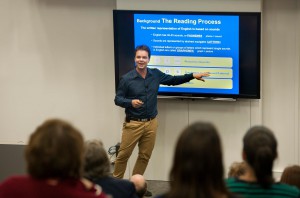 Teaching reading to those with dyslexia and other reading difficulties is in need of effective new approaches. Speaking at the Learning Difference Convention in Sydney recently, Dr Bartek Rajkowski, director of Adelaide Speech Pathology Services, said dyslexia is often misunderstood in the community and gave several examples of this in his address.
Teaching reading to those with dyslexia and other reading difficulties is in need of effective new approaches. Speaking at the Learning Difference Convention in Sydney recently, Dr Bartek Rajkowski, director of Adelaide Speech Pathology Services, said dyslexia is often misunderstood in the community and gave several examples of this in his address.
The first is that it is a disorder where letters or words are reversed or jump around the page making reading difficult. “This is incorrect as letter and word reversals are found in normally developing children. Some of those with severe dyslexia do not reverse letters or words.”
Another is that dyslexia is a visual disorder. “Research suggests the reading difficulties in those with dyslexia are cause by subtle language processing problems.” Also, he said it was particularly useful for educators and parents to be aware that while it was believed the disorder occurred more frequently in boys than girls, both genders are affected similarly. “Boys are overrepresented because they are likely to be referred for assessment usually as a result of behavioural issues whereas girls tended to be overlooked.” Finally it was untrue that people with dyslexia are more gifted. “The difficulties experienced by people with dyslexia are not confined to those with average or a high IQ and can occur in those with a low IQ,” Dr Rajkowski said.
So what is dyslexia? In a nutshell it is a specific learning disability characterised by difficulty in reading accuracy, reading fluency and spelling. It is neurologically based and runs in families. In the majority of cases the core problem lies in decoding ability. In other words, people with dyslexia have difficulty in working out words as they read. “Without this ability people are relying on pictures or someone else to explain the words instead of working it out for themselves. The outcome can be disastrous, since poor decoding causes difficulty in teaching oneself new words,” he said.
“There is a huge body of research showing that the main thing that interferes with the ability to decode in people with dyslexia is poor phonological processing – the understanding of and ability to process information related to the sounds of language. Examples of phonological processing skills include recalling a phone number or being able to name a limited set of items or letters quickly.
“The most important phonological processing skill that is weaker in people with dyslexia is called phonemic awareness. Phonemic awareness means understanding that words (such as ‘spoon’) consist of individual speech sounds (‘s-p-oo-n’). Strong phonemic awareness is the most powerful predictor of future reading skills in young children and is thought to give students an advantage in cracking the code of written language.”
In contrast, numerous studies have shown that children with dyslexia or related learning disabilities have the same visual function and ocular health as children without dyslexia. Subtle eye or visual problems including visual perceptive disorders, refractive error, abnormal focusing, jerky eye movements, binocular dysfunction or crossed eyes do not cause dyslexia.
Dr Rajkowski summed up his presentation by suggesting that the prevailing approach to the way reading is taught in Australian schools has to change and that educators recognise this. “There is an urgent need for explicit, systematic, evidence-based instruction in reading. Children must be taught about the relationship between the sound structure of language and the way we represent those sounds in written form. According to national enquiries into the teaching of reading in the US, UK and Australia, there is clearly strong evidence to support the teaching of synthetic phonics.”
The standard of reading in Australia remains a serious issue. In a 2011 international reading literacy study Australia ranked 27 out of 45 countries and was rated the worst of all English-speaking nations, below the USA, the UK, Canada and New Zealand. In another study on literacy levels among adults, 40 per cent of Australian adults were found to have a literacy level considered to be inadequate to deal with everyday issues.
Dr Rajkowski has developed the Reading Doctor suite of literacy improvement software and apps to assist in helping teachers and parents to teach synthetic phonics. He hopes his tools will lead to better outcomes for all students who are learning to read, especially those with reading difficulties such as dyslexia.
For more information visit: www.readingdoctor.com.au or PH: 1300 669 940
